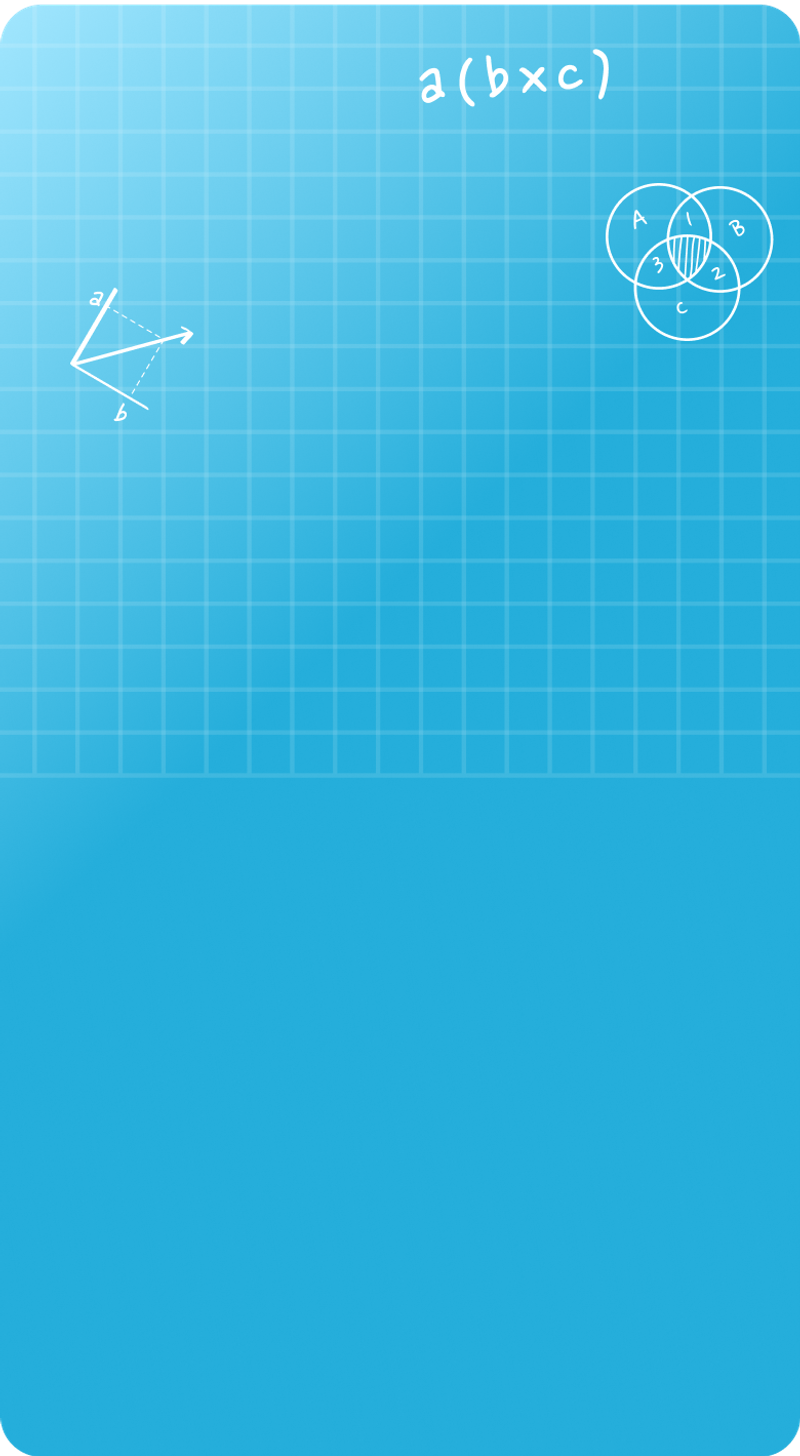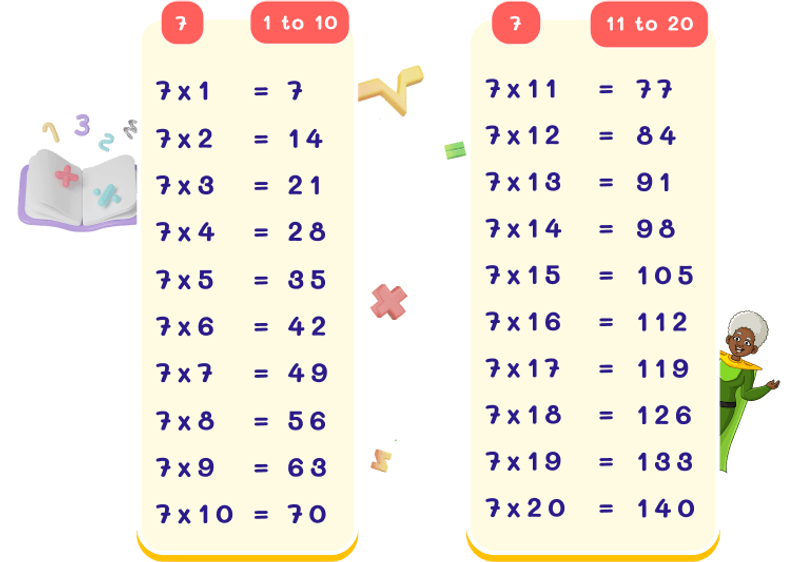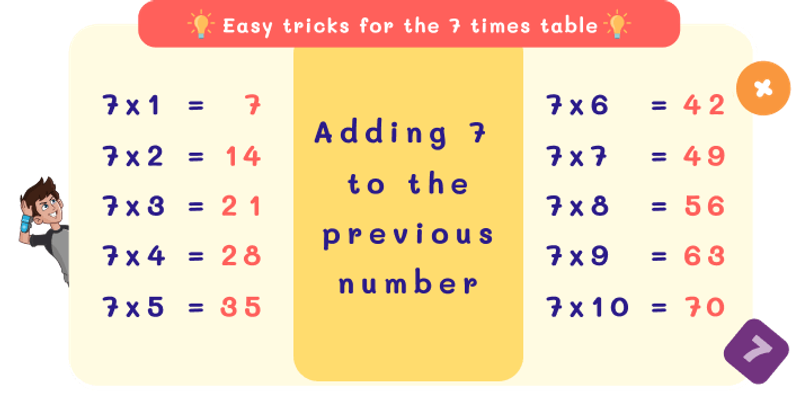Summarize this article:
 2183 Learners
2183 LearnersLast updated on August 5, 2025
7 Times Table

Table of 7 consists of the multiples of the number 7 when multiplied by numbers. Let's understand more about Table of 7.

What is a Multiplication Table of 7?
The table of 7 is a tricky multiplication table, and learning it requires a good understanding of the patterns and numbers it contains.
- Table of 7 consists of multiples of 7, a list with a structure that helps the learner calculate the sums of 7.
- The pattern followed by the table is repeated addition of 7 and keeps increasing as 7, 14, 21, 28, 35, 42, 49, 56, 63, 70…
- When 7 is multiplied by an even number, the result is even, and when multiplied by an odd number, the result is odd. For example, 7 x 3 = 21 and 7 x 6 = 42.
- The digits on the one’s place follow a pattern of 7, 4, 1, 8, 5, 2, 9, 6, 3, and 0, which repeats after every 10 multiples.

7 Times Table Chart
The table of 7 is hard to understand completely and takes time to comprehend.
Here is the table of 7 from the multiples 1 to 10 and 11 to 20.
| TABLE OF 7 (1-10) | |
|---|---|
|
7 x 1 = 7 |
7 x 6 = 42 |
|
7 x 2 = 14 |
7 x 7 = 49 |
|
7 x 3 = 21 |
7 x 8 = 56 |
|
7 x 4 = 28 |
7 x 9 = 63 |
|
7 x 5 = 35 |
7 x 10 = 70 |
| TABLE OF 7 (11-20) | |
|---|---|
|
7 x 11 = 77 |
7 x 16 = 112 |
|
7 x 12 = 84 |
7 x 17 = 119 |
|
7 x 13 = 91 |
7 x 18 = 126 |
|
7 x 14 = 98 |
7 x 19 = 133 |
|
7 x 15 = 105 |
7 x 20 = 140 |

Tips and Tricks for the Multiplication Table of 7
Table of 7 may be a little hard and takes more time to understand. Practicing it regularly can make it easy.
- The table of 7 can be broken down into parts, and learning them in parts will be an easy method for completely understanding the table.
- The table of 7 can also be learned by relating it to the other tables of 6 and adding the number of multiples. For example, 7 x 3 = 21, which can be done by calculating 6 x 3 = 18 + 3 = 21.
- As 7 is a prime number, the repetition of the pattern will only happen after 10 multiples.
- The table of 7 can also be practiced using the skip counting method, i.e., by counting 7’s: 7, 14, 21, 28, 35, 42, 49, 56, 63, 70, and so on.
The tips and tricks above will help you in the 7 times table. The common mistakes and the solved examples show where to look out for and how to solve problems with the table of 7.
Explore Our Programs



Common Mistakes and How to Avoid Them in 7 Times Tables
Committing mistakes while learning the table of 7 is common. You can avoid making these mistakes by being more careful in the area mentioned below.

7 Times Table Examples

Problem 1
A hall has 7 rows with 18 seats each. How many people can the hall accommodate at a time?

Total number of rows = 7
Total number of seats per row = 18
The total number of people the hall can accommodate = Total number of rows x Total number of seats per row
7 x 18 = 126
Answer: 126 people.
Explanation
The number of rows should be multiplied by the number of seats per row, 7 x 18. The answer will be 126.

Problem 2
The sum of three consecutive multiples of 7 is 126. Find the numbers.

Let the consecutive multiples be; 7n, 7n+1, 7n+2
Their sum is given as;
7n+7(n+1)+7(n+2) = 126
Simplify the given equation;
7n+7n+7+7n+14 = 126
21n+21=126
Subtract 21 from both sides;
21n=105
We now solve for n;
n= 105/21 = 5
The three consecutive multiples are;
7×5 = 35
7×6 = 42
7×7 = 49
Explanation
The numbers ascertained by following the above steps are 35,42 and 49.

Problem 3
7×y=63 and 7×z= 84. Find y/z?

We first ascertain the values of y and z;
y= 63/7 =9
z= 84/7 =12
Now, we divide y/z;
9/12 = 3/4
y/z = 3/4
Explanation
We find y/z by following the above steps.


FAQs on 7 Times Table
1.Explain a method to memorize the table of 7.
2.What is the pattern followed by the table of 7?
3.What is 7 times 18?
4.How to check if multiplication by 7 is correct or not?
5.How do I use the multiplication table of 7 in the division?

Important Glossaries for Multiples of 7
- Factor: Factors are the numbers that can be multiplied to get a product.
- Skip counting: Counting by 7 to get the products quickly.
- Inverse operation: Operations that undo each other.
- Multiple: The number that can be evenly divided by another number.
- Product: The result obtained when multiplication is performed.



Seyed Ali Fathima S
About the Author
Seyed Ali Fathima S a math expert with nearly 5 years of experience as a math teacher. From an engineer to a math teacher, shows her passion for math and teaching. She is a calculator queen, who loves tables and she turns tables to puzzles and songs.
Fun Fact
: She has songs for each table which helps her to remember the tables



















